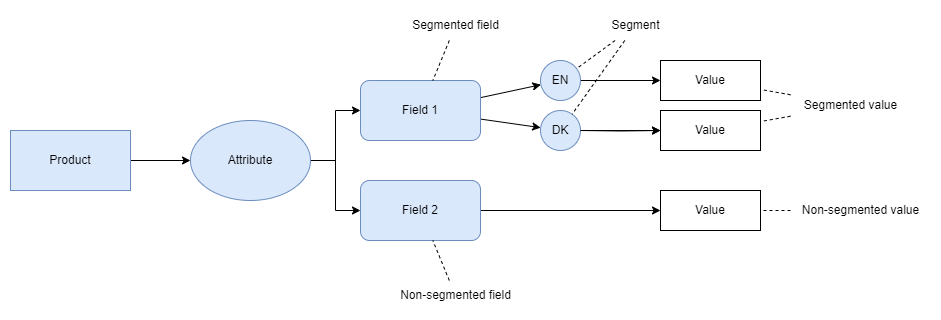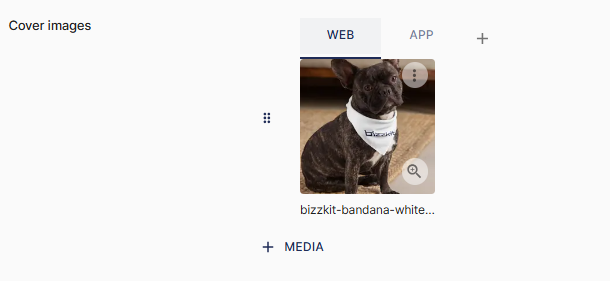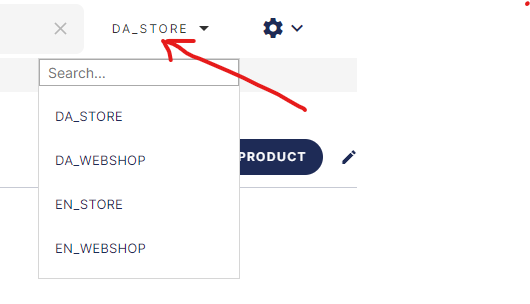Segmentations
Segmentations and dimensions are key concepts in Bizzkit PIM allowing information such as product attributes to be targeted to specific segments of end users. Segments represent different views of the attribute values, while segmentation dimensions describe the four different ways in which attribute values can be segmented. A basic example of segmentation is a product description attribute that varies by language. In this case, the segment is the language (e.g., English, Danish, Swedish), and the dimension is the translation culture.
Bizzkit PIM manages segmentation at the attribute value level, meaning that individual attribute fields can hold specific values for each available segment.
One of the large benefits this approach has is that a single product catalog can target multiple segments without having to duplicate any products if they're available in different segments. All entities with an attribute collection (product catalogues, product categories, global lists items, etc.) are therefore able to target specific segments, which provides a lot of flexibility when working with product data.
Some examples of segmentation in PIM
Segmented boolean for showing/hiding product or category in specific segments
This example shows an attribute called Is active which has a channel segmented field. The attribute can be used to control whether a product or category should be shown on respectively the B2B or B2C storefront.
It also has a default segment which acts as a fallback, in case there's no value set for any of the other segments.
Language specific product descriptions
A common example is segmentation based on language (translation culture), as shown below for the English/Danish segmented values on the Description attribute.
Segmented images for different devices
Another example is segmentation based on device, where images can be targeted to specific devices. In the example below, the Cover image attribute has a segmented field for the Web and App segments.
Dimensions
Information can be segmented by up to four dimensions, namely market, channel, device, translation culture.
Some combination of these four dimensions makes up a segmentation.
Market
Represents a market in which products in the product catalogue are available.
Channel
Represents a channel through which products in the product catalogue are being sold. For example an online store, Facebook, Amazon etc.
Device
Represents a device that an end user (online store customer) is using to buy products in the product catalogue. For example a desktop computer, iPhone, iPad, and the like.
Translation culture
Represents a language that an end user speaks or understands.
A translation culture may be either a combination of language and country like for example 'en-GB' or only language like for example 'en'.
The former may be used for languages that vary in different countries such as American English (en-US) vs. British English (en-GB).
Segmentation
Represents a well-known combination of Market, Channel, Device and Translation culture.
An external system that requests information in PIM must state the value of each dimension.
For example: Some external system requesting information might be an online store (Channel dimension) that operates in Denmark (Market dimension) and the end user is using a tablet (Device dimension) and is physically located in Denmark and speaks Danish (Translation culture dimension).
The external system can request a view of a product catalogue item targeted to the segmentation that is defined by those four dimensions.
Info
A segmentation has an Auto publish to frontend flag which, if set to true, causes PIM to pre build views for that specific segmentation.
Segmentation key
A subset of segmentation dimensions used as a lookup key by segmented pim types. Is used to resolve values for a specific segmented type.
For example the segmented type PTranslatedStringD uses Translation culture as its segmentation key meaning that it segments strings on translation culture.
The segmented type PResponsiveMediaBank6FileD uses Device as its segmentation key meaning it segments images on device.
If a requirement for types that segment on more than one dimension comes up, PIM supports that as well, however currently (April 2023) multi-dimensional segmented types are not yet exposed.
Preferred segmentation
The preferred segmentation setting controls which segmentation preset is used in segmented PIM type controls in the UI. It can be set by selecting a segmentation from the segmentation selector in the top bar of PIM.
Note
The preferred segmentation only affects the current user and only affects the user's UI session(s). It does not in any affect Resolved views.
It is purely a usability improvement which makes it easier to work with segmented values in the UI.
Preferred segmentation-aware content
When a preferred segmentation is set, this segmentation will be used to display segmented data types in the UI. The following list can be used as a reference of content that is aware of the currently selected preferred segmentation and will adapt its content accordingly.
General
- Items in dropdown list for referential types when setting attribute values or in filters, such as:
- Attribute names
- Global list items
- Predefined values
-
When adding a segmented attribute to the product list, the segmentation matching the preferred segmentation is added as column
Note
This behavior doesn't apply to segmented types with a default value. The default value will be used instead.
Product detail page
- When setting a value for attributes of segmented types, the currently set preferred segmentation is pre-selected. This applies to:
- PTranslated(D) types
- PChannelSpecific(D) types





